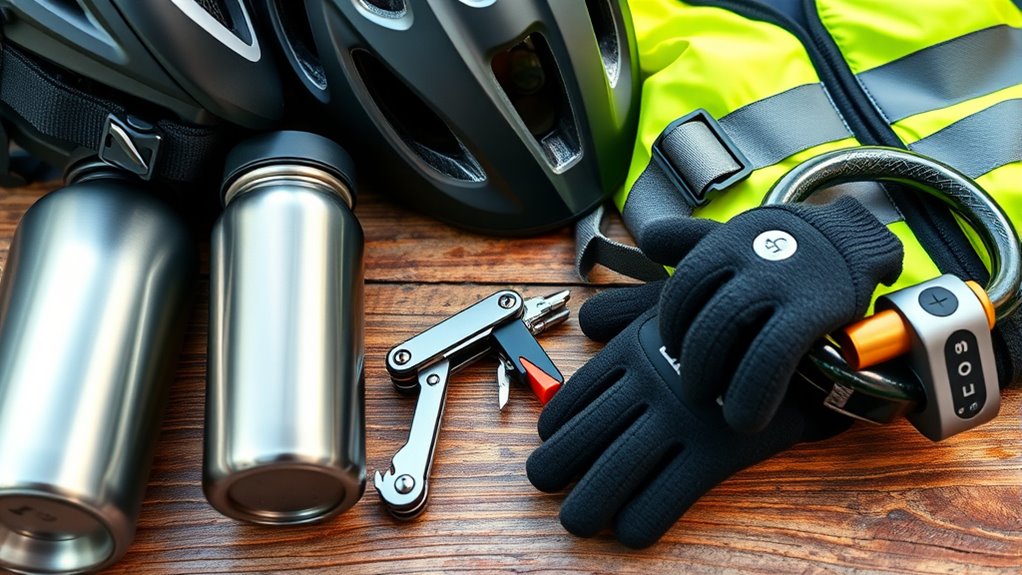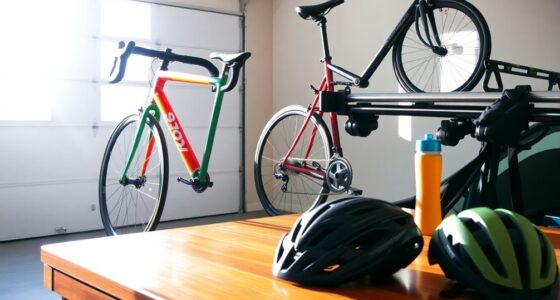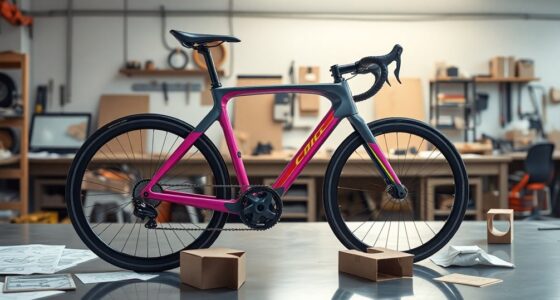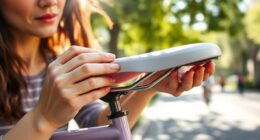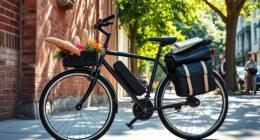To stay safe and comfortable, equip your bike with a well-fitting helmet, bright LED lights, and reflective gear for visibility, especially at night. A sturdy lock helps prevent theft, while cycling gloves and padded shorts improve comfort on longer rides. Carry a basic repair kit for quick fixes, and always keep essentials like a water bottle and small bag nearby. For more tips on making your rides safer and smoother, keep exploring these must-have accessories.
Key Takeaways
- Safety gear including a well-fitting helmet, reflective clothing, and lights for enhanced visibility.
- Basic repair kit like a spare tube, tire levers, and pump for quick fixes.
- Proper bike lock to prevent theft and secure your bike when parked.
- Comfortable apparel such as padded shorts and cycling gloves for longer rides.
- Accessories like a water bottle, handlebar bag, and a bell for convenience and safety.
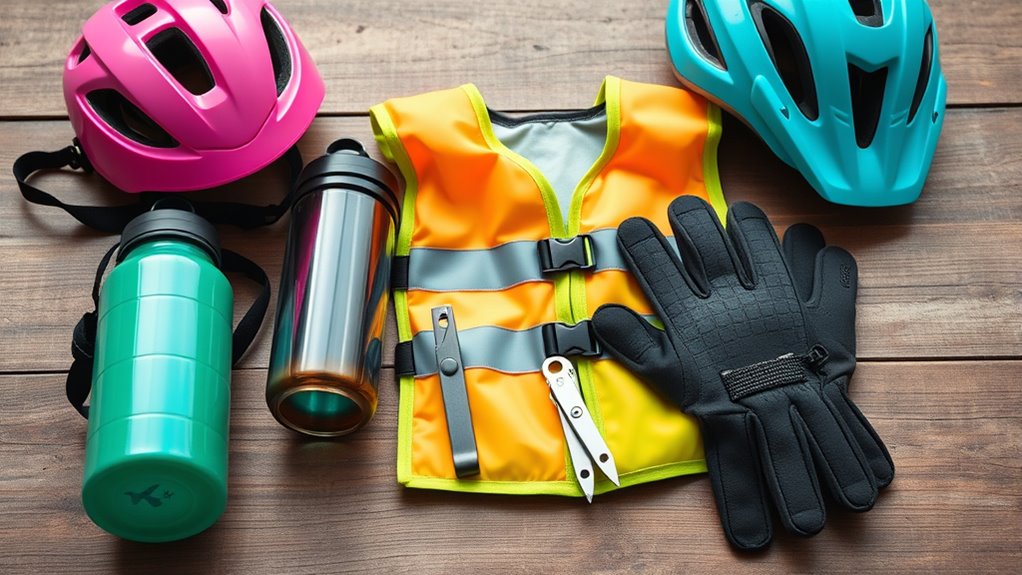
Starting out as a new cyclist can be exciting, but having the right accessories makes your ride safer and more enjoyable. When you’re just getting started, it’s easy to overlook essential gear, but investing in a few key items can considerably improve your experience. First and foremost, a well-fitting helmet is non-negotiable. It protects your head in case of falls or accidents and should sit snugly without being too tight. Look for one with adjustable straps and good ventilation to stay comfortable on longer rides. Safety should always come first, so don’t skimp on this piece of gear.
Next, consider adding a bike lock to your arsenal. Even if you’re just stopping for a quick break or running errands nearby, locking your bike deters theft. Choose a sturdy lock, preferably a U-lock or a heavy-duty chain lock, and always lock your bike to a secure, immovable object. This small investment can save you from losing your bike altogether.
Visibility is another critical aspect of safe cycling, especially if you plan to ride in low-light conditions or at night. Equip your bike with front and rear lights—bright LED lights are highly recommended because they’re visible from a distance. Additionally, wearing reflective gear or accessories increases your visibility to motorists. Reflective vests, ankle straps, and stickers on your bike help ensure you’re seen from all angles. Incorporating proper bike fit can further enhance comfort and efficiency during your rides. Also, selecting accessories made from approved metals can help prevent corrosion and ensure durability over time.
Comfort is key to enjoying your rides, so think about grabbing a good pair of gloves. Cycling gloves improve grip, reduce vibration, and protect your hands if you fall. They can also wick away sweat, keeping your hands dry and comfortable. If you’re planning longer rides, padded shorts or cycling tights can make a substantial difference by reducing chafing and providing extra support. Additionally, understanding city traffic rules and signage can help you navigate more confidently and safely, especially as a new cyclist. Being aware of bike maintenance techniques and how to address common issues will also help you stay on the road longer and avoid unnecessary delays.
To stay hydrated and carry essentials, a water bottle and holder are must-haves. Look for a bottle that fits comfortably in your bike’s cage, and keep it filled with water or electrolyte drinks. A small handlebar bag or a backpack is also handy for storing your phone, wallet, keys, and repair tools. Carrying a basic repair kit— including a spare tube, tire levers, a pump, and a multi-tool— prepares you for common issues like flat tires. Additionally, understanding the importance of proper storage and the types of approved metals can help you make informed decisions when selecting accessories or investing in longer-term gear.
Finally, consider adding a bell or horn to alert pedestrians and other cyclists of your presence. It’s a simple safety feature that can prevent accidents and make your rides more courteous. With these accessories in place, you’ll feel more confident and secure on your bike, ready to enjoy every ride with peace of mind.
Frequently Asked Questions
How Do I Choose the Right Bike Helmet Size?
To choose the right bike helmet size, you should measure your head around the widest part, usually about an inch above your eyebrows. Use a soft measuring tape for accuracy. Try on helmets in different sizes, ensuring they sit snugly without feeling tight. Adjust the straps so they form a V under your ears, and make sure the helmet sits level and low on your forehead for maximum protection.
What Safety Accessories Are Essential for Night Riding?
Imagine you’re stepping into the glow of a streetlamp, just like a knight preparing for battle at dawn. For night riding, you need essential safety accessories like a bright front light and a red rear light to stay visible. Add reflective gear or stickers, and wear a reflective vest. These tools help you stand out in the dark, ensuring you’re seen by drivers and other cyclists alike.
How Often Should I Replace My Bike Tires?
You should replace your bike tires when the tread wears down considerably or if you notice frequent flats. Check for cracks, cuts, or embedded debris regularly. Usually, tires last between 1,000 to 3,000 miles, but this varies based on terrain and riding style. If you feel less grip or notice uneven wear, it’s time for new tires. Staying attentive helps guarantee safe, smooth rides and prolongs your bike’s performance.
Are Waterproof Accessories Necessary for All Weather Conditions?
Did you know that cycling in all weather conditions can increase your bike’s lifespan? Waterproof accessories aren’t necessary for all weather, but they’re highly beneficial in rain or snow. They keep your gear dry, prevent rust, and guarantee safety. If you ride frequently in unpredictable weather, investing in waterproof covers, jackets, and lights is wise. Otherwise, regular accessories may suffice, but staying prepared helps you ride confidently year-round.
What Tools Should I Carry for Basic Bike Repairs?
When it comes to basic bike repairs, you should carry a multi-tool with screwdrivers, Allen wrenches, and a chain tool. A patch kit and spare tubes are essential for fixing flats. Also, bring a tire pump or CO2 inflator to re-inflate your tires. These tools help you handle common issues on the road, ensuring you can get back riding quickly and safely without needing immediate professional help.
Conclusion
Now that you know the must-have accessories, you’re all set to hit the road with confidence. Remember, a well-equipped cyclist is a happy cyclist, so don’t overlook these essentials. They’ll help keep you safe, comfortable, and ready for anything that comes your way. Think of it as having your ducks in a row—when you’re prepared, riding becomes a true pleasure. So gear up, enjoy the ride, and make every trip a great adventure!
